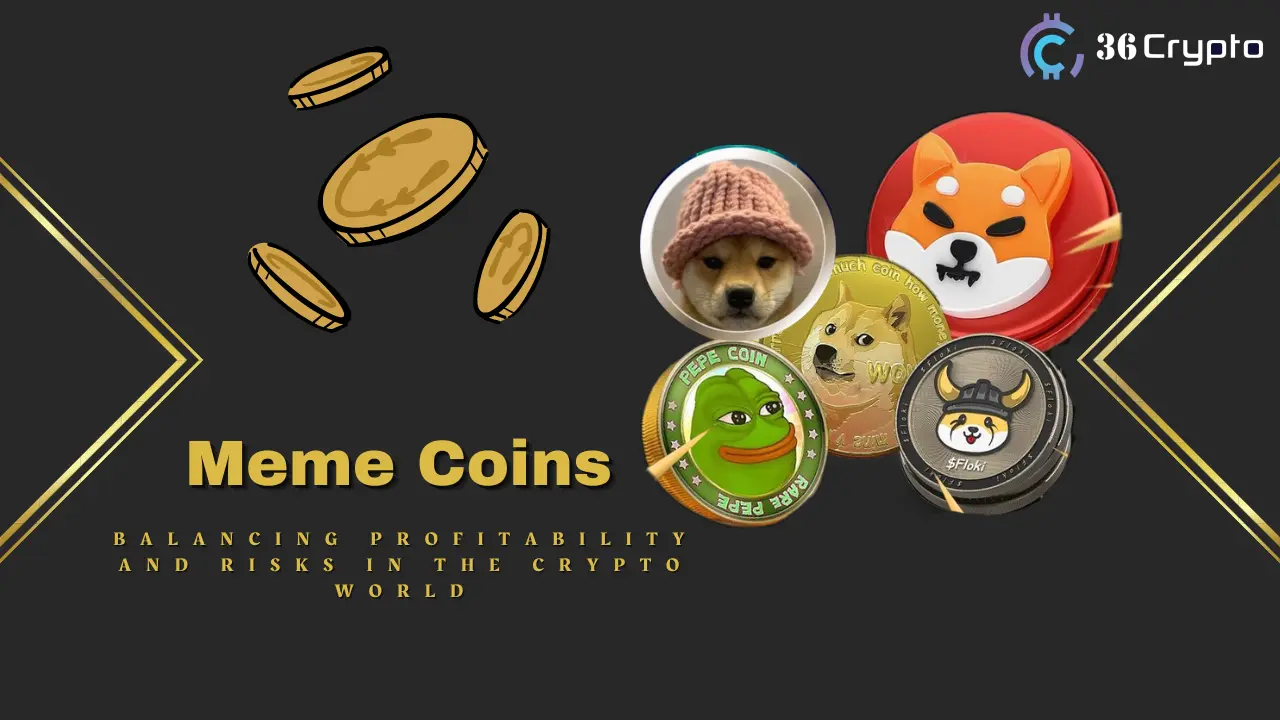Every day, while drinking coffee, we scroll through our social media feeds, stopping at memes to chill out a bit. The crypto industry went further and, inspired by certain memes, created a specific cryptocurrency based on them.
Initially, they were created as a joke, but over time, more and more crypto enthusiasts have shown interest in these coins. According to a recent report by CoinGecko, meme coins became the most profitable cryptocurrency in the first quarter of 2024, recording the highest yield of 1312.6% on average among the most popular tokens.
Why do meme coins attract the attention of crypto users, which ones are of the greatest interest, and what is the problem with these cryptocurrencies? These are the main topics of today’s article.
Dogecoin (DOGE)
Dogecoin is a decentralized meme coin created in 2013, inspired by the popular Doge meme about the Japanese dog Shiba Inu. Created as a joke, it quickly became one of the leading cryptocurrencies. Thanks to the support of celebrities such as Elon Musk, Mark Cuban, and Snoop Dogg, the coin has grown in value by more than 4000% in 2021 alone. Elon Musk’s influence on the Dogecoin price is still significant, as his statements continue to boost the value of the coin.
DOGE features:
One of the features of the coin is the unlimited number of coins, meaning that Dogecoin can be mined an unlimited number of times, which leads to constant inflation. This makes DOGE less suitable for storing value, but more useful for transactions, such as tipping or small payments.
Another important feature is the speed of transactions. A block is completed every minute, unlike Bitcoin, where it takes up to ten minutes.
The other advantage of Dogecoin is its low transaction cost, which makes it a cheaper alternative to services such as PayPal.
However, the coin also has its cons. Since Dogecoin is decentralized, no single organization owns or controls it. Therefore, it is necessary to conduct research before investing, because, in case of theft or fraud, no one will be able to compensate you for your losses.
Floki Inu (FLOKI)
Another coin associated with Elon Musk is the Floki Inu. This time, however, it has to do with its name, which plays on what Musk named his dog Shiba Inu.
Floki features:
FLOKI was initially launched on the Ethereum blockchain, but later the meme coin appeared on the Binance Smart Chain (BSC). As a result, the coin has become one of the few that have a unique multi-chain protocol, where a small commission from each transaction goes directly to the marketing and development teams. This commission structure supports influencer engagement, donations, and contributions to new updates to the Floki Inu ecosystem.
Floki Inu offers four main community projects:
- Valhalla: an NFT gaming metaverse
- FlokiFi: a set of decentralized financial products
- FlokiPlaces – a marketplace for NFTs and goods
- Floki University – a content and educational platform
Moreover, holders of coins also have their privileges. They can hold their tokens and get rewarded for it. 4% of the reward is distributed among Floki holders in the BSC and ETH blockchains every time someone exchanges tokens on a crypto exchange. In addition, unlike most meme coins, FLOKI can be used to purchase goods at more than 1500 stores through a partnership with CryptoCart (CC).
Shiba Inu (SHIB)
Shiba Inu is a decentralized cryptocurrency created in 2020 by an anonymous person or group of people under the pseudonym “Ryoshi”. Similar to Dogecoin, it is based on the Doge meme, which features a dog of the Shiba Inu breed. The coin is even called a “Dogecoin killer”.
A white paper (the so-called “woofpaper”) about SHIB describes it as a community-based cryptocurrency project. That is, the control over the cryptocurrency and its development is exercised by the decentralized Shiba Inu community, known as the “ShibArmy”.
A significant moment for the coin came in 2021 when the founder sent half of the stock to Ethereum co-founder Vitalik Buterin. However, Buterin did not appreciate the gift and donated 10% of the tokens and burned the remaining 90%.
Even though the coin was originally known as an alternative to Dogecoin, it still has a key difference. Because Shiba Inu was launched on Ethereum, it can run smart contracts. With the help of this, the coin can work with decentralized applications.
SHIB can be used for peer-to-peer digital payments and as a payment method for companies, but it is not as widely accepted as other cryptocurrencies.
The Shiba Inu ecosystem also includes the following tools:
- ShibaSwap: a decentralized exchange
- Shiba Inu Incubator: here, talented people from the ShibArmy can express their creativity and create their works of art.
- Shiboshis: 10,000 non-fungible tokens (NFTs) generated in the Shiba Inu ecosystem and permanently stored on the Ethereum blockchain, with various features that make each of them unique and collectible.
Dogwifhat (WIF)
Dogwifhat is a meme coin created on the Solana blockchain that depicts a dog named Shiba Inu wearing a pink hat. The coin has attracted considerable attention from the cryptocurrency community and has broken into the top 100 most popular cryptocurrencies in the industry, surpassing well-known meme coins in terms of trading volume and market capitalization. Like all its competitors, WIF has an active and dedicated community that promotes the coin at every opportunity.
It has recently been listed on various exchanges such as Kraken, WhiteBIT, KuCoin, and others, which has become an exciting event in the cryptocurrency community.
However, the coin has a big drawback – it has no product, benefit, or team. WIF has no use other than to buy and hope that the price will go up. In the future, Dogwifhat will have a hard time sustaining itself when new meme coins come to market, as it will have no development team and no products or services to create. However, for now, WIF shows us the power of an active community and what it can accomplish even if the underlying asset lacks utility or a unique selling point.
Pepe (PEPE)
Pepe is a meme coin created on the Ethereum blockchain in 2023, based on the internet meme Pepe the Frog. The token has a unique redistribution system that incentivizes investors to keep their tokens, increasing the stability of the token and increasing its long-term chances of success.
PEPE stands out in the active cryptocurrency market due to its unusual theme dedicated to the frog Pepe. The cryptocurrency community’s devotion to this character adds a certain charm to the coin, making it stand out from the competition. In addition, PEPE has several unique features that also distinguish it from other meme coins.
It operates under a tax-free policy, incentivizes long-term investment decisions through a system of redistributing rewards among stakeholders, and uses a coin-burning mechanism to regulate the number of PEPE coins in circulation.
The Disadvantages Of Meme Coins
Even though these coins are quite popular among users, they still have certain disadvantages and risks associated with investing in them.
- High risk of volatility: The price of meme coins is highly volatile, as it is heavily influenced by community sentiment and arbitrary external influences such as celebrity tweets. The value of a particular coin can rise rapidly, as happened with Dogecoin, but it can also fall very quickly if and when the community loses interest in it and moves on.
- Lack of regulation: Such coins are often not subject to the same level of regulation as other cryptocurrencies, which can make them more vulnerable to fraud and scams.
- Lack of long-term sustainability: Meme coins are often created as short-term investments, with little consideration given to their long-term sustainability or growth potential. This can make them particularly risky for investors who want to preserve their investment in the long term.
What Else Can Meme Coins Be?
Recently, Vitalik Buterin spoke about the issue of meme coins on his website. The expert notes that meme coins will be the most discussed topic in the community in 2024. However, Buterin emphasizes that “there isn’t anything particularly new and interesting about the memecoins. Often quite the opposite: a bunch of Solana memecoins have recently been openly super-racist. And even the non-racist memecoins often seem to just go up and down in price and contribute nothing of value in their wake.” Supporting his statements with screenshots of disgruntled users.
Buterin also emphasized the potential of meme coins as a third form of financing technology that serves various social causes (e.g., AntiCancerCoin or ClimateCoin).
According to the Ethereum founder, he is looking forward to meme coin projects that support social good rather than enrich insiders and creators.
“I want to see higher quality fun projects that contribute positively to the ecosystem and the world around them (and not just by “bringing in users”) get more mindshare. At the least, more good memecoins than bad ones, ideally those that support public goods instead of just enriching insiders and creators.” Buterin writes.
The spread of problematic coins has sparked a lot of discussion among the cryptocurrency community. At the recent BUIDL Asia Summit in Seoul, the Solana Foundation addressed this controversy and shared its vision of how to solve the problem. Austin Federa, Chief Strategy Officer at Solana Foundation, drew a parallel between the crypto ecosystem and the Internet.
Federa said: “Choice means the right for a wallet developer to institute a block list. Almost every wallet in every ecosystem filters out spam NFTs and spam tokens. Users always can reveal something if they want to, but the core network needs to remain permissionless.”
He also emphasized that it is unreasonable to expect an Internet Service Provider (ISP) to filter potentially offensive content.
“No one expects Verizon to have a legal obligation to prevent a phishing email from landing in your inbox or to prevent you from accessing something that is potentially racist material,” he said. “Solana is all on the application level. It’s wallets making decisions about the kind of content they want to show and display.”
On a different note, Mark Zeller, founder of the Aave Chan Initiative, emphasized that in some countries, such as France, internet providers have a legal obligation to block certain types of content.
“I’m not saying it’s a good thing, nor am I trying to be political. It’s interesting to point out that different cultures have different approaches to the same issue,” he said. “Focusing on the blockchain ethos, we tend to support free speech and believe that censorship resistance is more important than eliminating displeasing content.”
Summary
Due to their popularity, meme coins have become the most profitable category among cryptocurrencies. Despite this, you should also keep in mind all the risks and disadvantages of these coins. After all, they have both positive and negative aspects that need to be analyzed and taken into account before investing.
Free Tool: Use our simple crypto profit calculator to calculate your potential profits and returns on your cryptocurrency investments.<<<
Read Also: Liquidations Hit Bulls Amidst Bitcoin and Altcoins Drop, Why is the Market Down?


